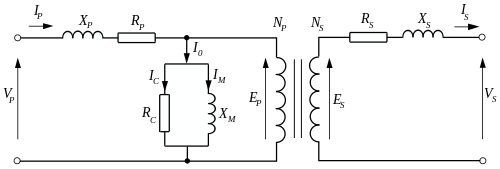Electrical power systems
In electrical power systems, voltage regulation is a dimensionless quantity defined at the receiving end of a transmission line as:
- [1]
where Vnl is voltage at no load and Vfl is voltage at full load. The percent voltage regulation of an ideal transmission line, as defined by a transmission line with zero resistance and reactance, would equal zero due to Vnl equaling Vfl as a result of there being no voltage drop along the line. This is why a smaller value of Voltage Regulation is usually beneficial, indicating that the line is closer to ideal.
The Voltage Regulation formula could be visualized with the following: "Consider power being delivered to a load such that the voltage at the load is the load's rated voltage VRated, if then the load disappears, the voltage at the point of the load will rise to Vnl."
Voltage regulation in transmission lines occurs due to the impedance of the line between its sending and receiving ends. Transmission lines intrinsically have some amount of resistance, inductance, and capacitance that all change the voltage continuously along the line. Both the magnitude and phase angle of voltage change along a real transmission line. The effects of line impedance can be modeled with simplified circuits such as the short line approximation (least accurate), the medium line approximation (more accurate), and the long line approximation (most accurate).

The short line approximation ignores capacitance of the transmission line and models the resistance and reactance of the transmission line as a simple series resistor and inductor. This combination has impedance R + jωL or R + jX. There is a single line current I = IS = IR in the short line approximation, different from the medium and long line. The medium length line approximation takes into account the shunt admittance, usually pure capacitance, by distributing half the admittance at the sending and receiving end of the line. This configuration is often referred to as a nominal - π. The long line approximation takes these lumped impedance and admittance values and distributes them uniformly along the length of the line. The long line approximation therefore requires the solving of differential equations and results in the highest degree of accuracy. [2]
In the voltage regulation formula, Vno load is the voltage measured at the receiving end terminals when the receiving end is an open circuit. The entire short line model is an open circuit in this condition, and no current flows in an open circuit, so I = 0 A and the voltage drop across the line given by Ohm’s law Vline drop = IZline is 0 V. The sending and receiving end voltages are thus the same. This value is what the voltage at the receiving end would be if the transmission line had no impedance. The voltage would not be changed at all by the line, which is an ideal scenario in power transmission.
Vfull load is the voltage across the load at the receiving end when the load is connected and current flows in the transmission line. Now Vline drop = IZline is nonzero, so the voltages and the sending and receiving ends of the transmission line are not equal. The current I can be found by solving Ohm’s law using a combined line and load impedance: . Then the VR, full load is given by .
The effects of this modulation on voltage magnitude and phase angle is illustrated using phasor diagrams that map VR, VS, and the resistive and inductive components of Vline drop. Three power factor scenarios are shown, where (a) the line serves an inductive load so the current lags receiving end voltage, (b) the line serves a completely real load so the current and receiving end voltage are in phase, and (c) the line serves a capacitive load so the current leads receiving end voltage. In all cases the line resistance R causes a voltage drop that is in phase with current, and the reactance of the line X causes a voltage drop that leads current by 90 degrees. These successive voltage drops are summed to the receiving end voltage, tracing backward from VR to VS in the short line approximation circuit. The vector sum of VR and the voltage drops equals VS, and it is apparent in the diagrams that VS does not equal VR in magnitude or phase angle.

The diagrams show that the phase angle of current in the line affects voltage regulation significantly. Lagging current in (a) makes the required magnitude of sending end voltage quite large relative to the receiving end. The phase angle difference between sending and receiving end is minimized, however. Leading current in (c) actually allows the sending end voltage magnitude be smaller than the receiving end magnitude, so the voltage counterintuitively increases along the line. In-phase current in (b) does little to affect the magnitude of voltage between sending and receiving ends, but the phase angle shifts considerably.
Real transmission lines typically serve inductive loads, which are the motors that exist everywhere in modern electronics and machines. Transferring a large amount of reactive power Q to inductive loads makes the line current lag voltage, and the voltage regulation is characterized by decrease in voltage magnitude. In transferring a large amount of real power P to real loads, current is mostly in phase with voltage. The voltage regulation in this scenario is characterized by a decrease in phase angle rather than magnitude.
Sometimes, the term voltage regulation is used to describe processes by which the quantity VR is reduced, especially concerning special circuits and devices for this purpose (see below).





